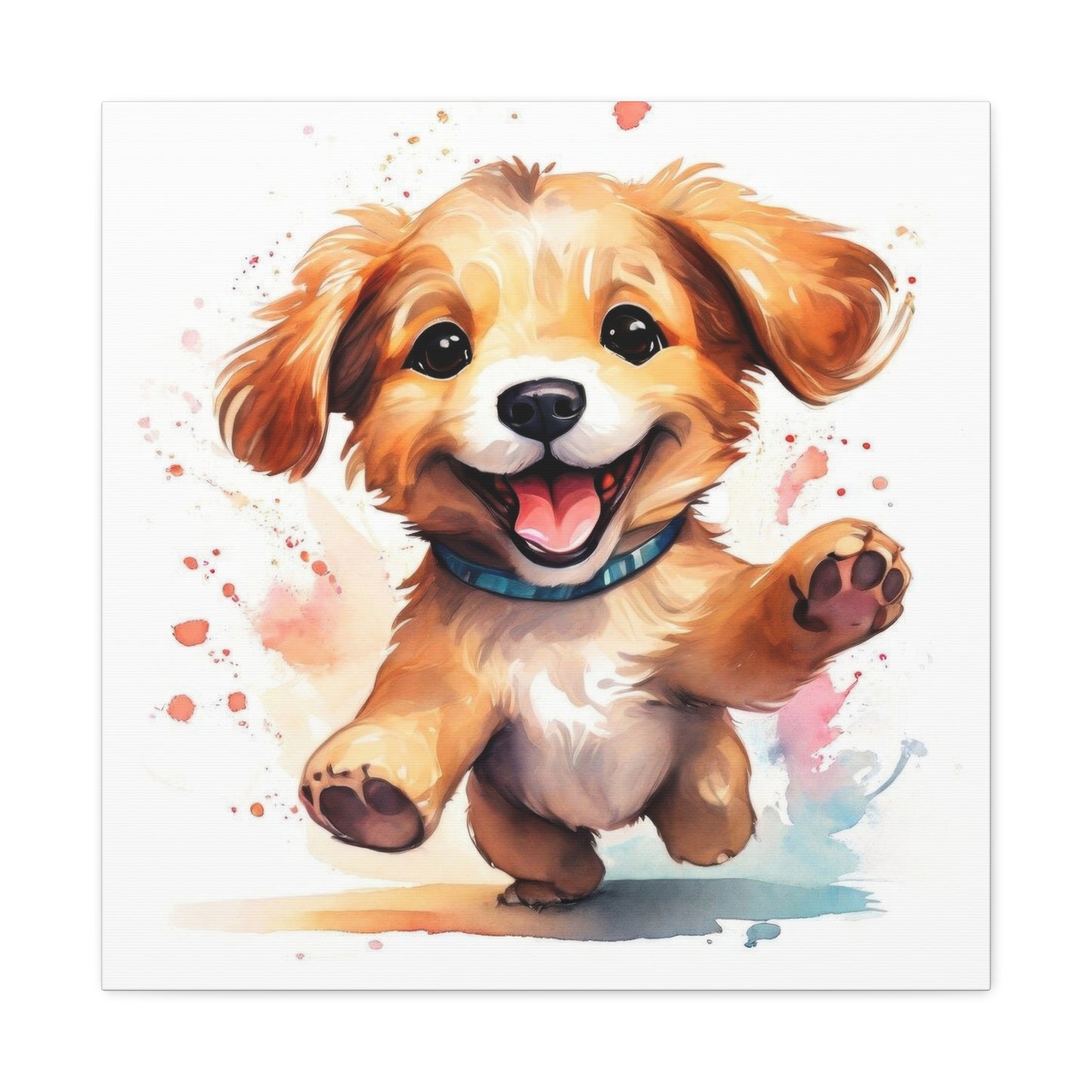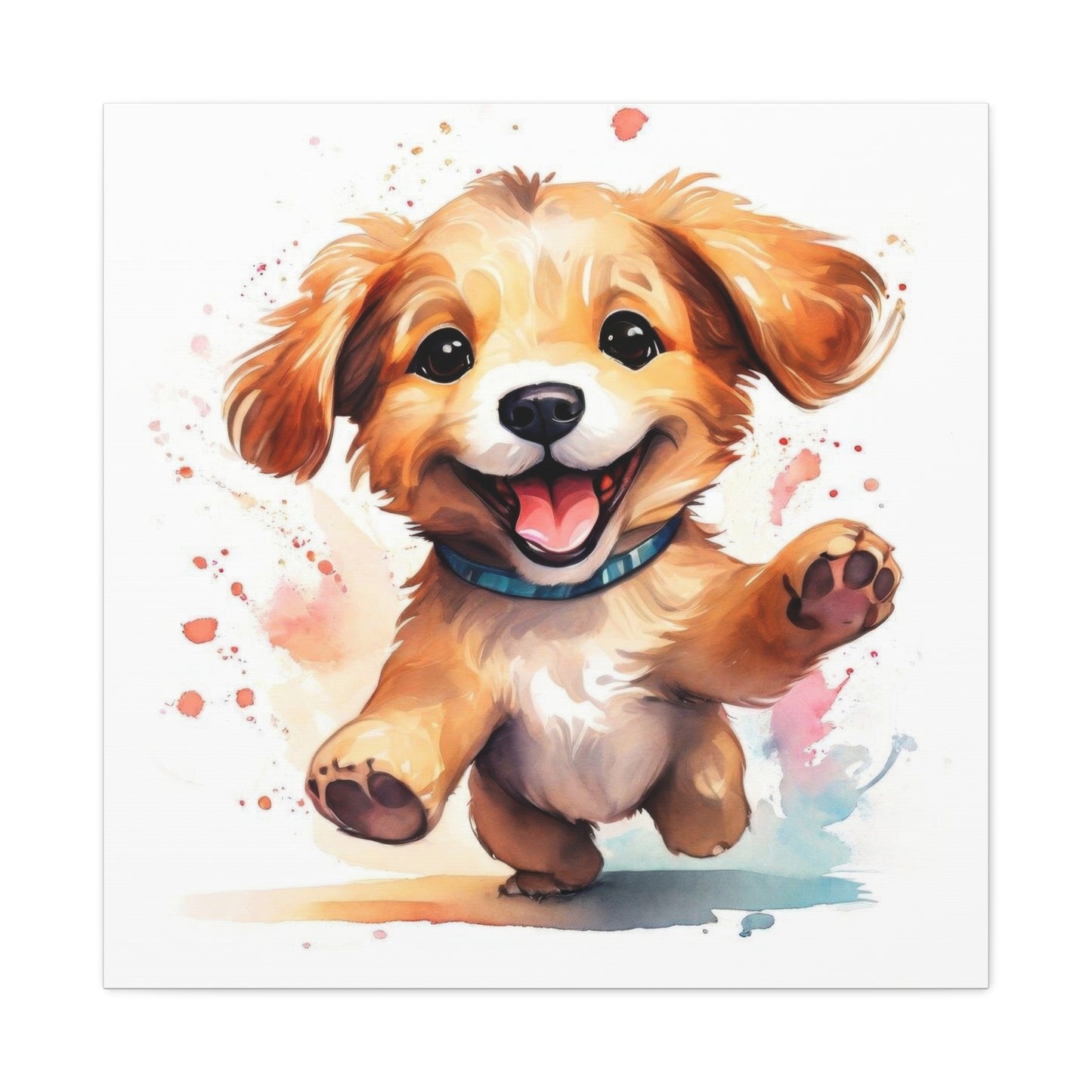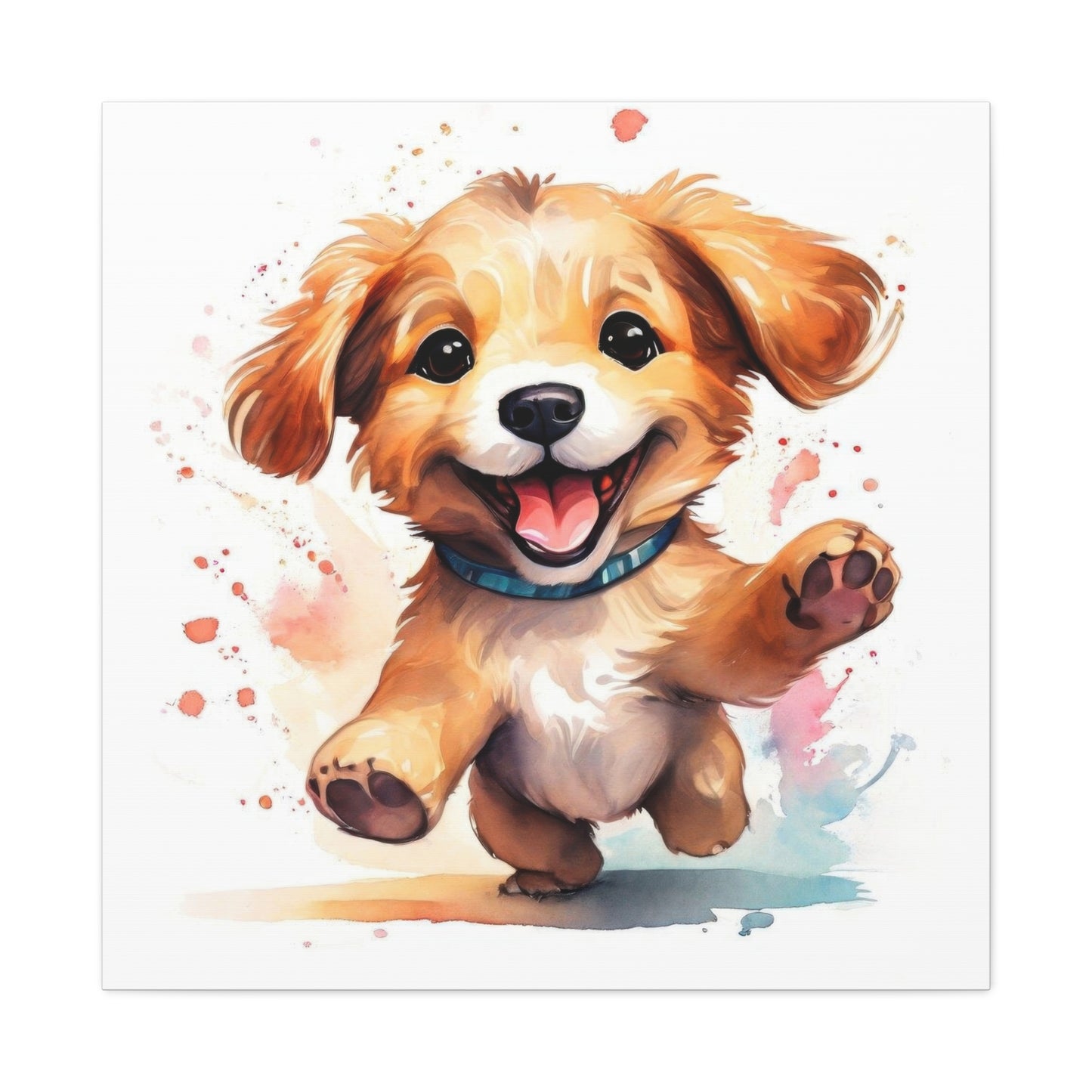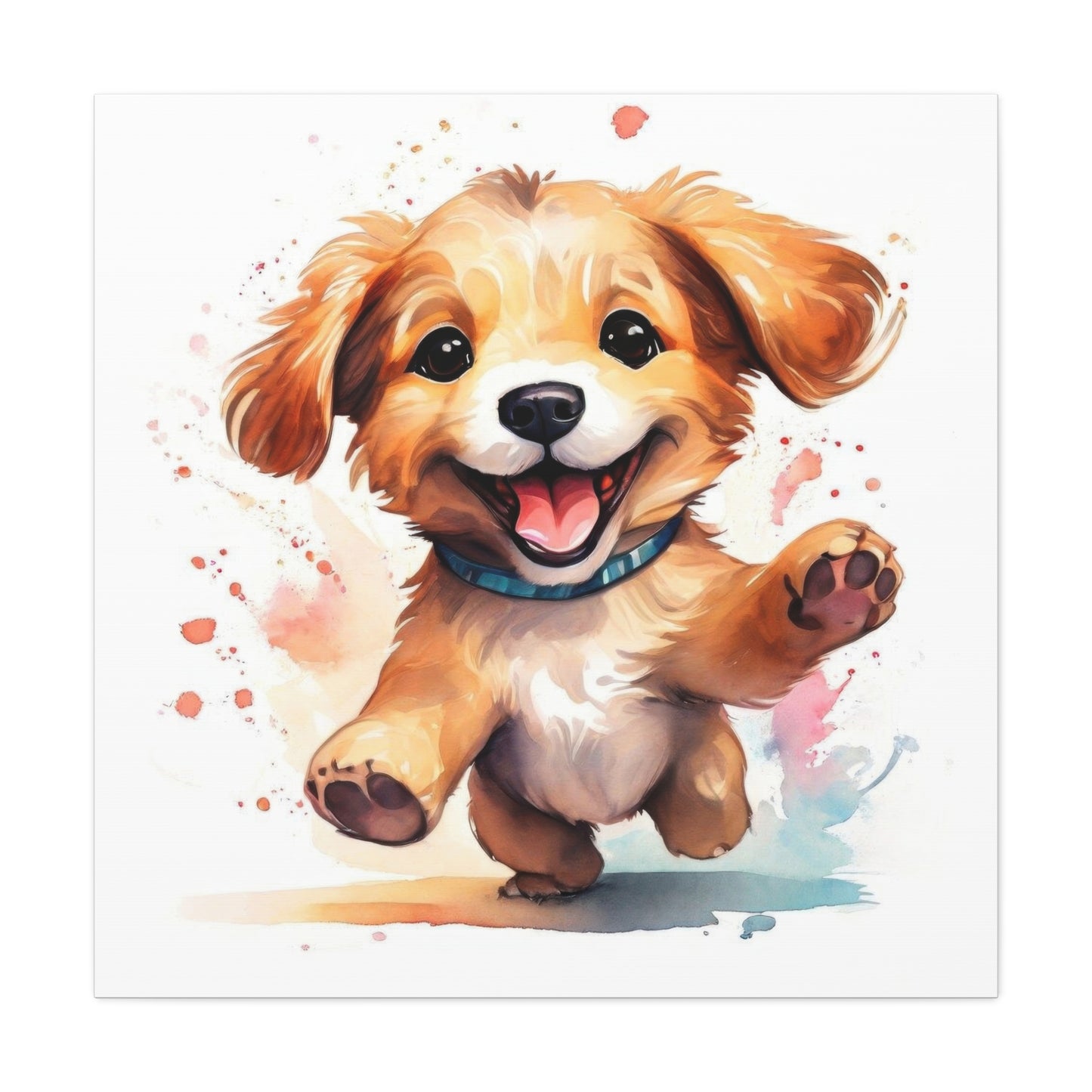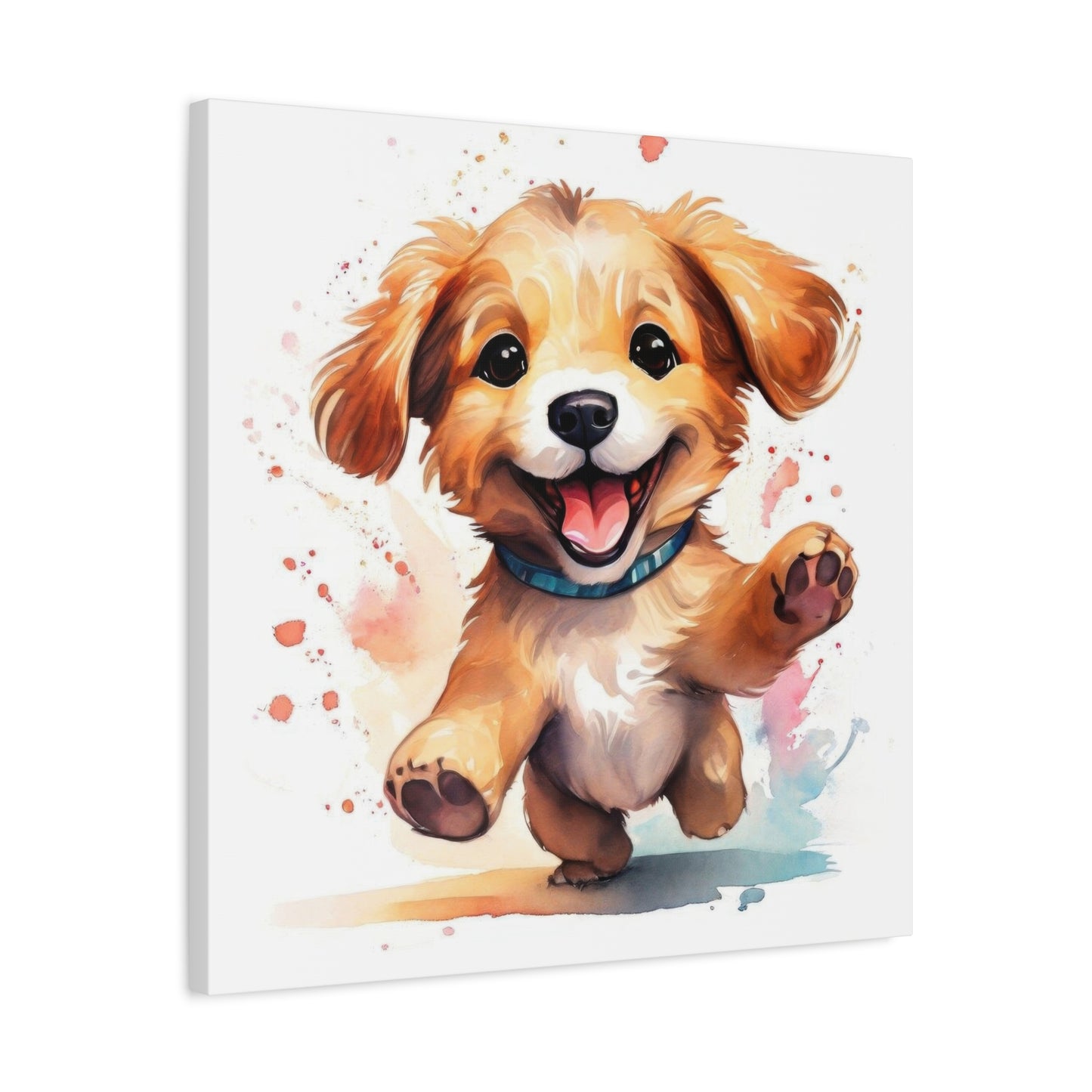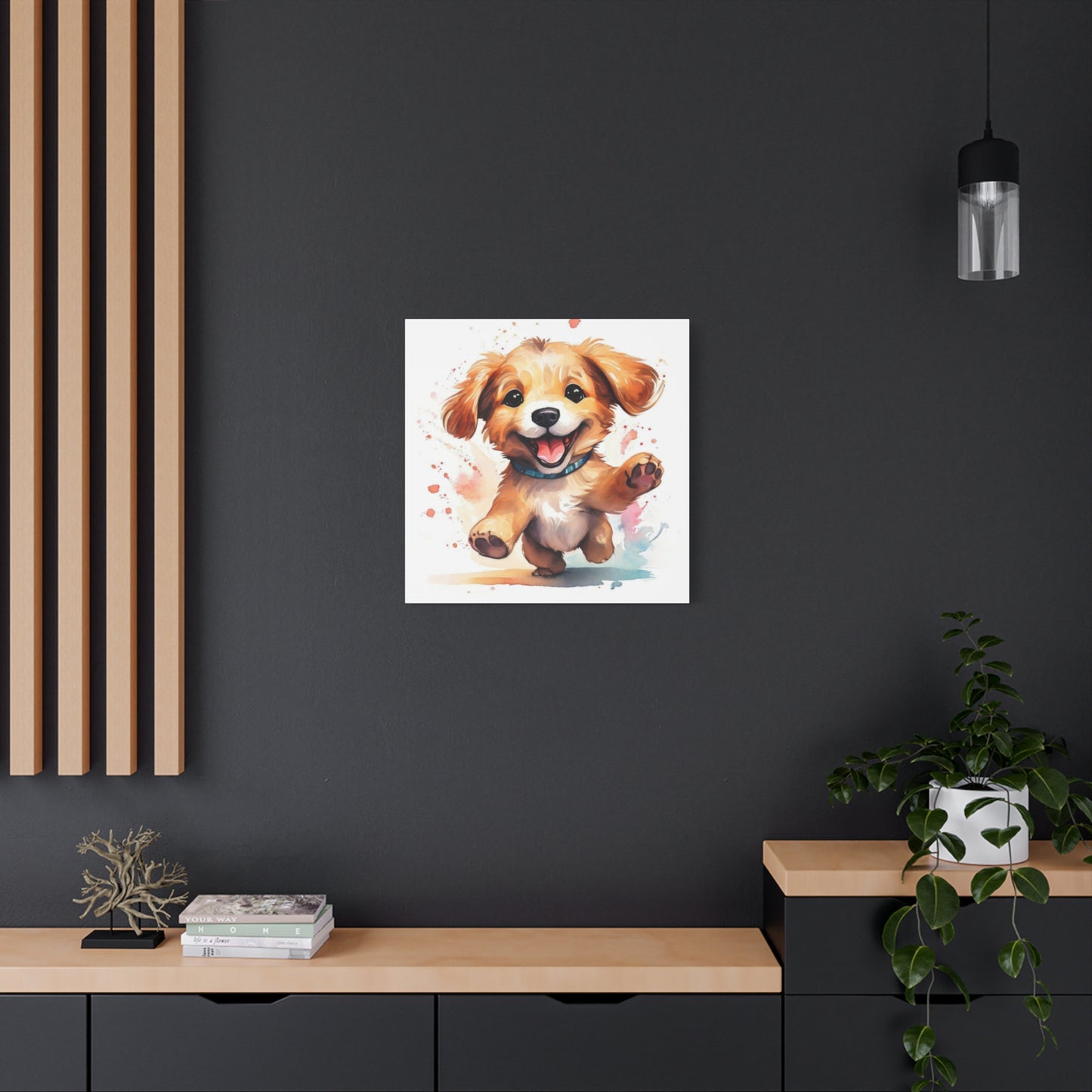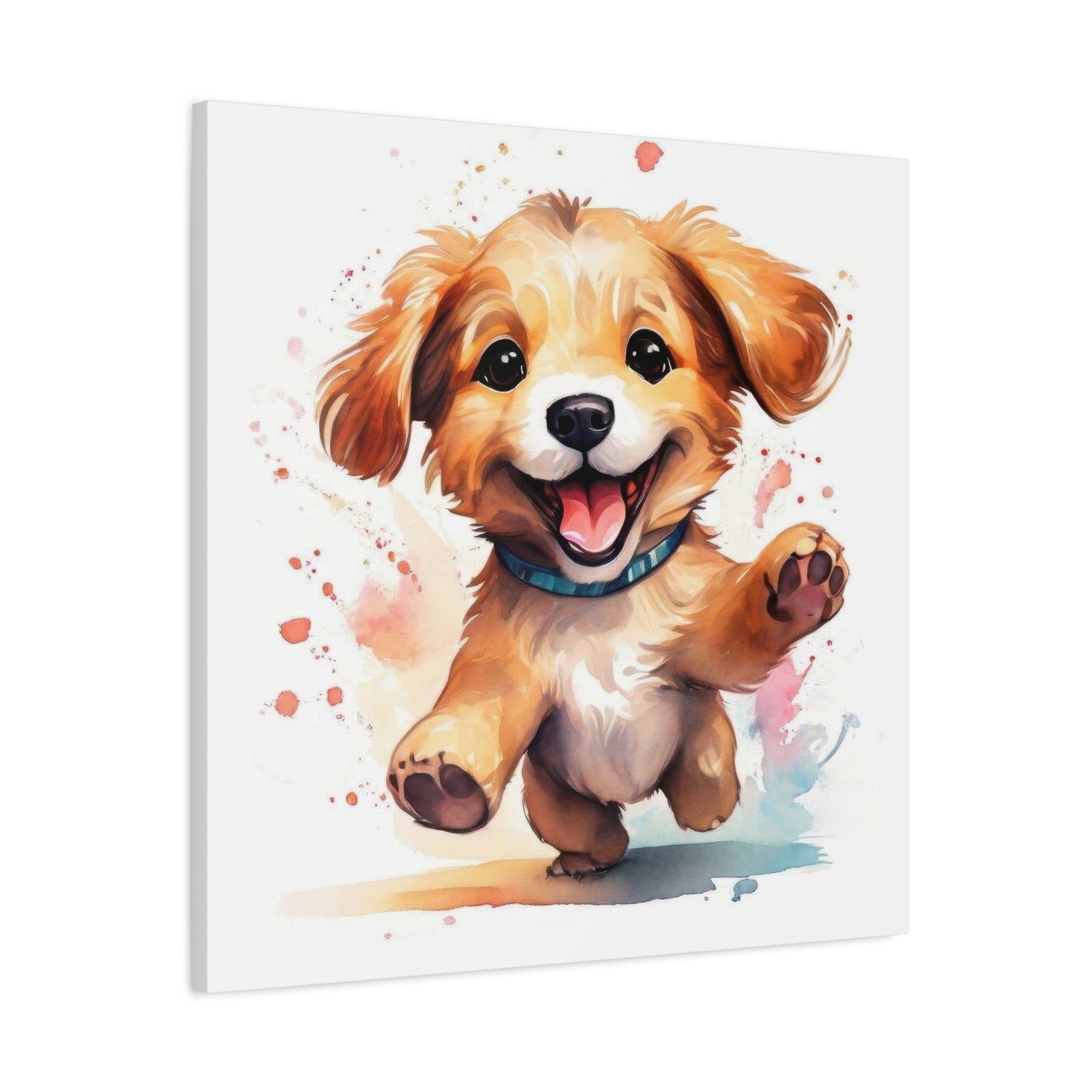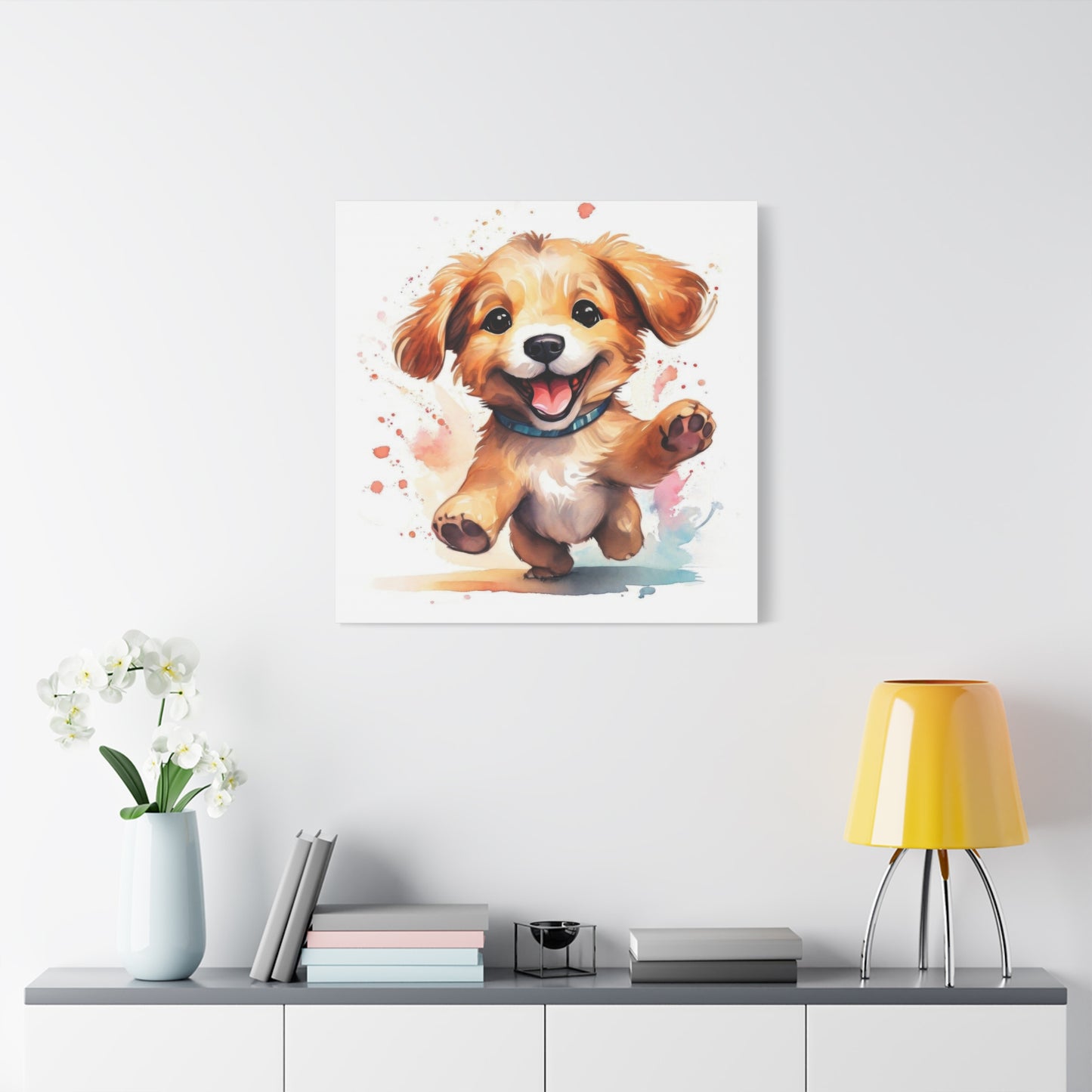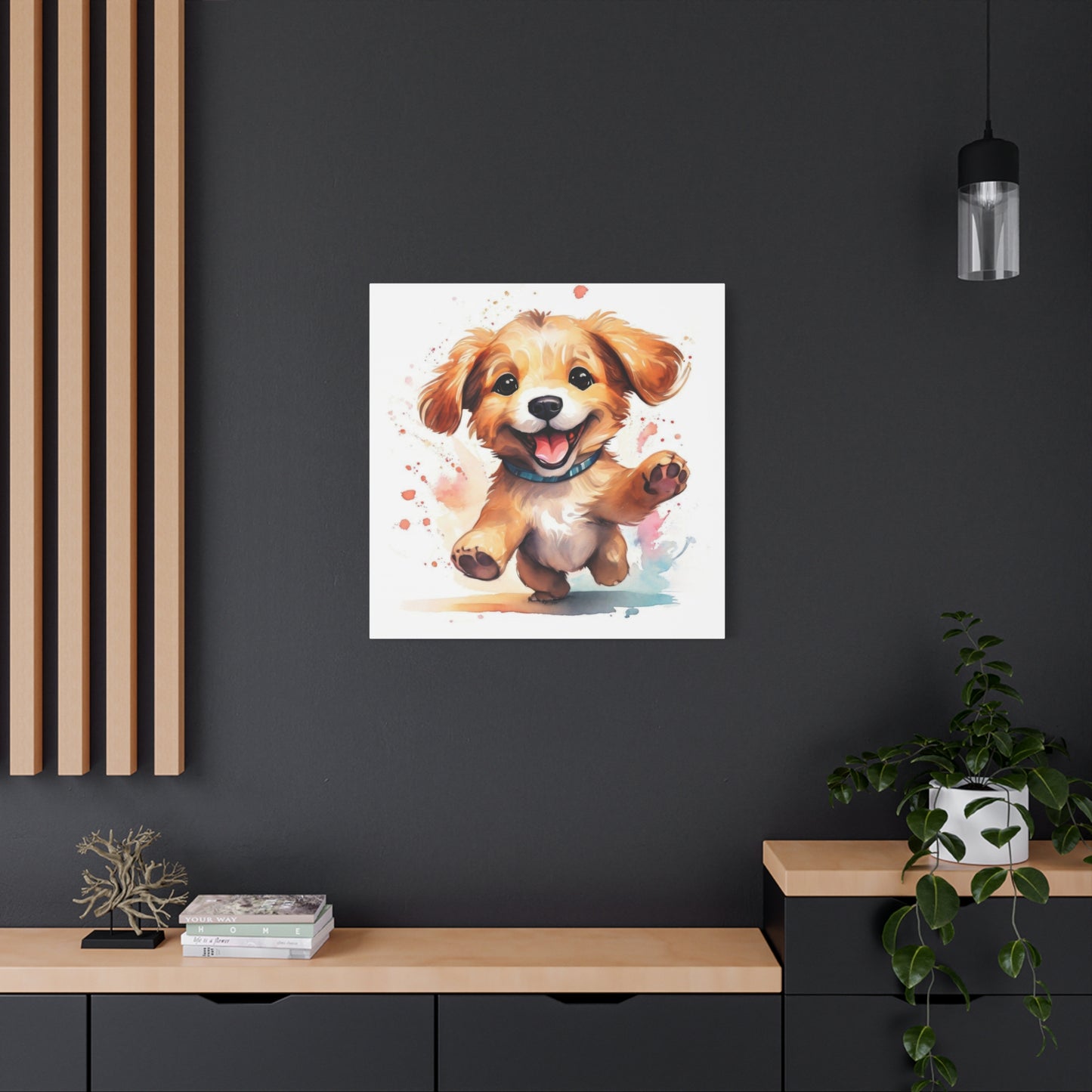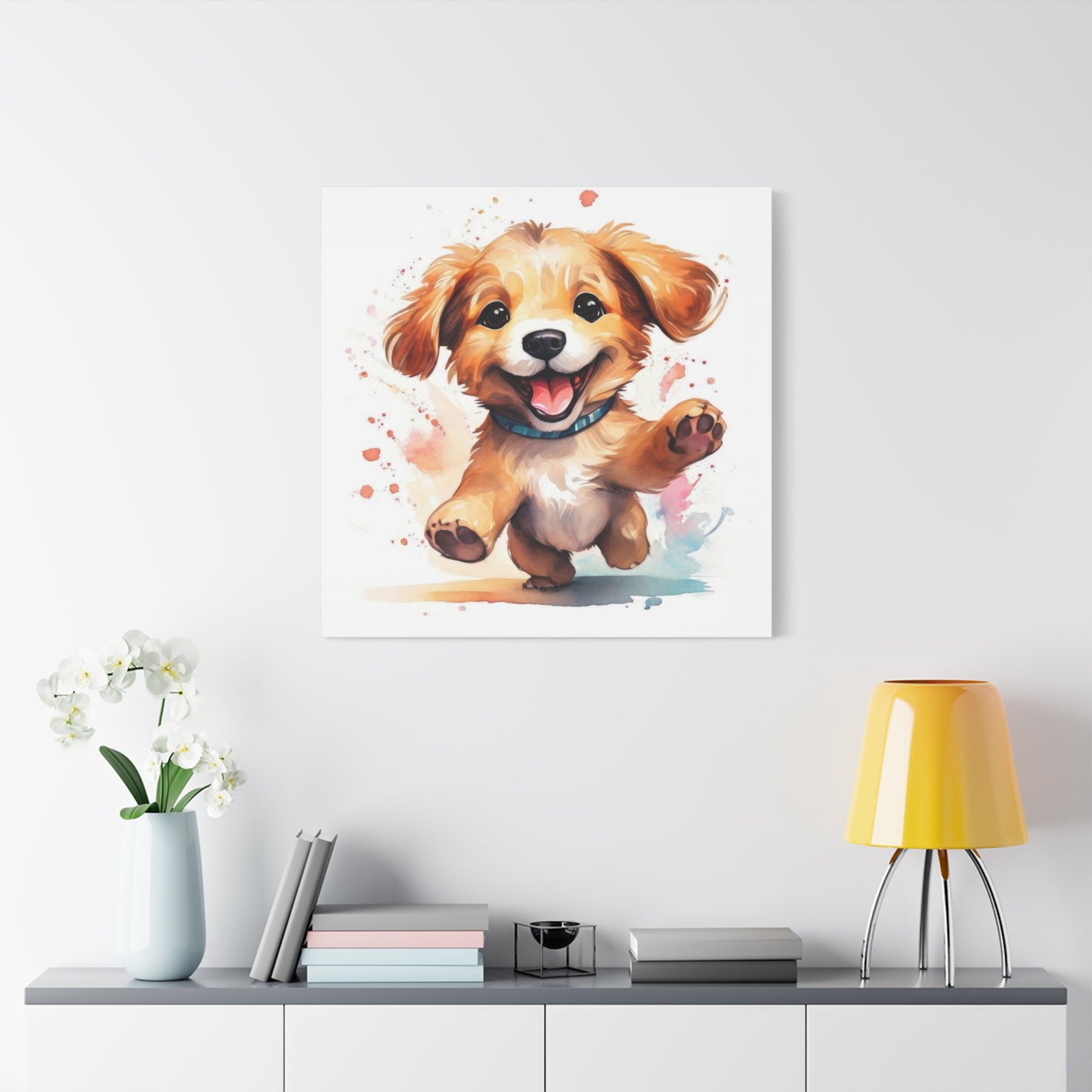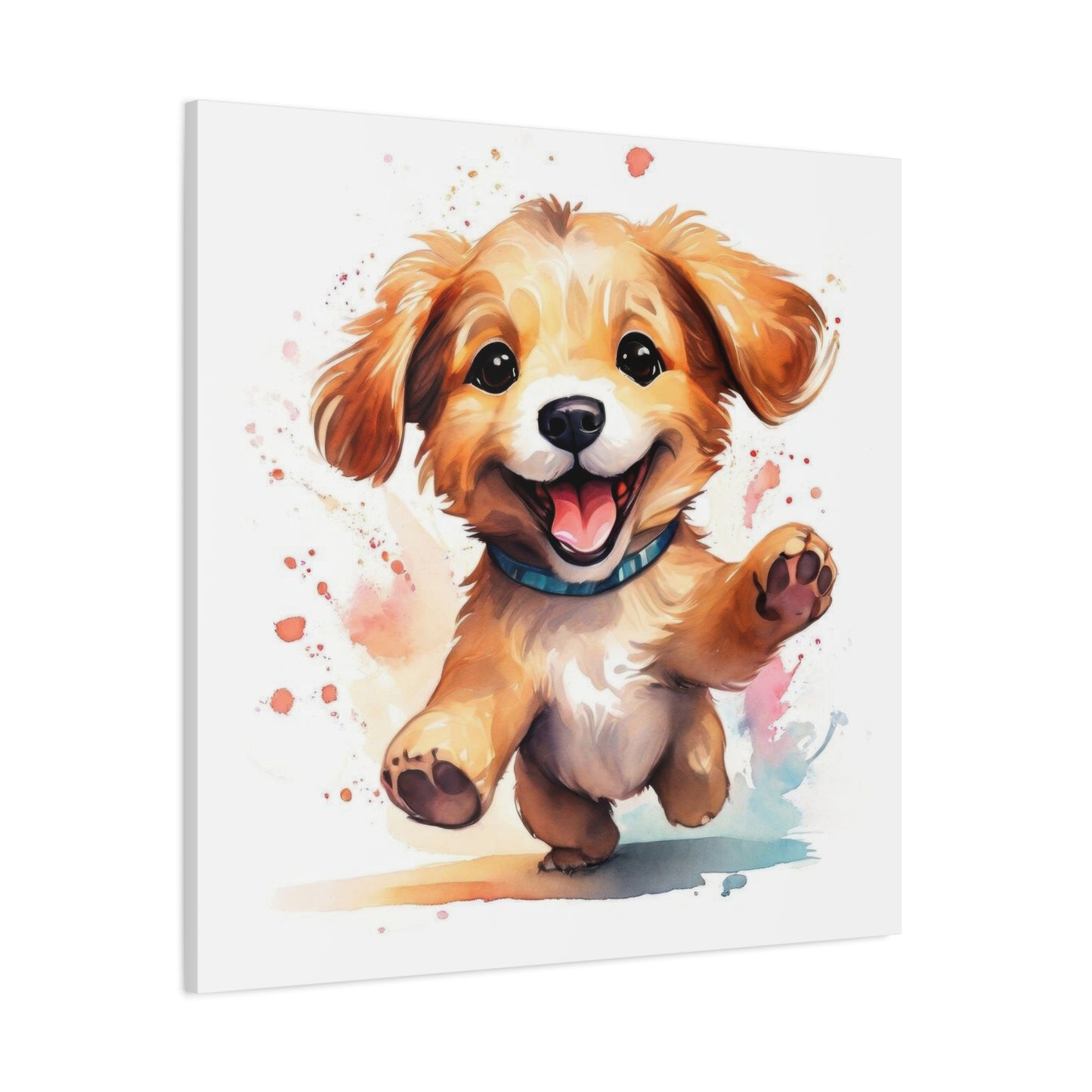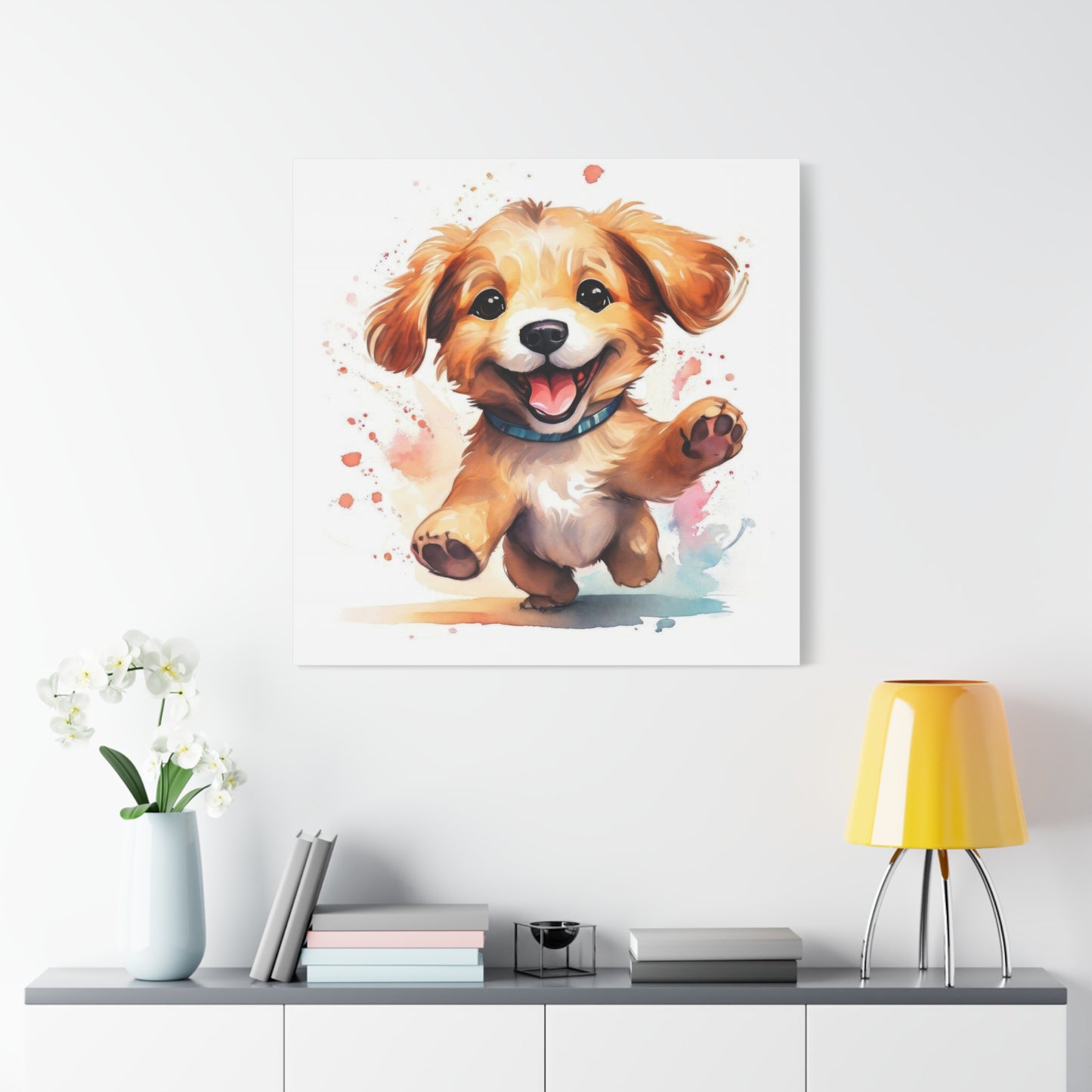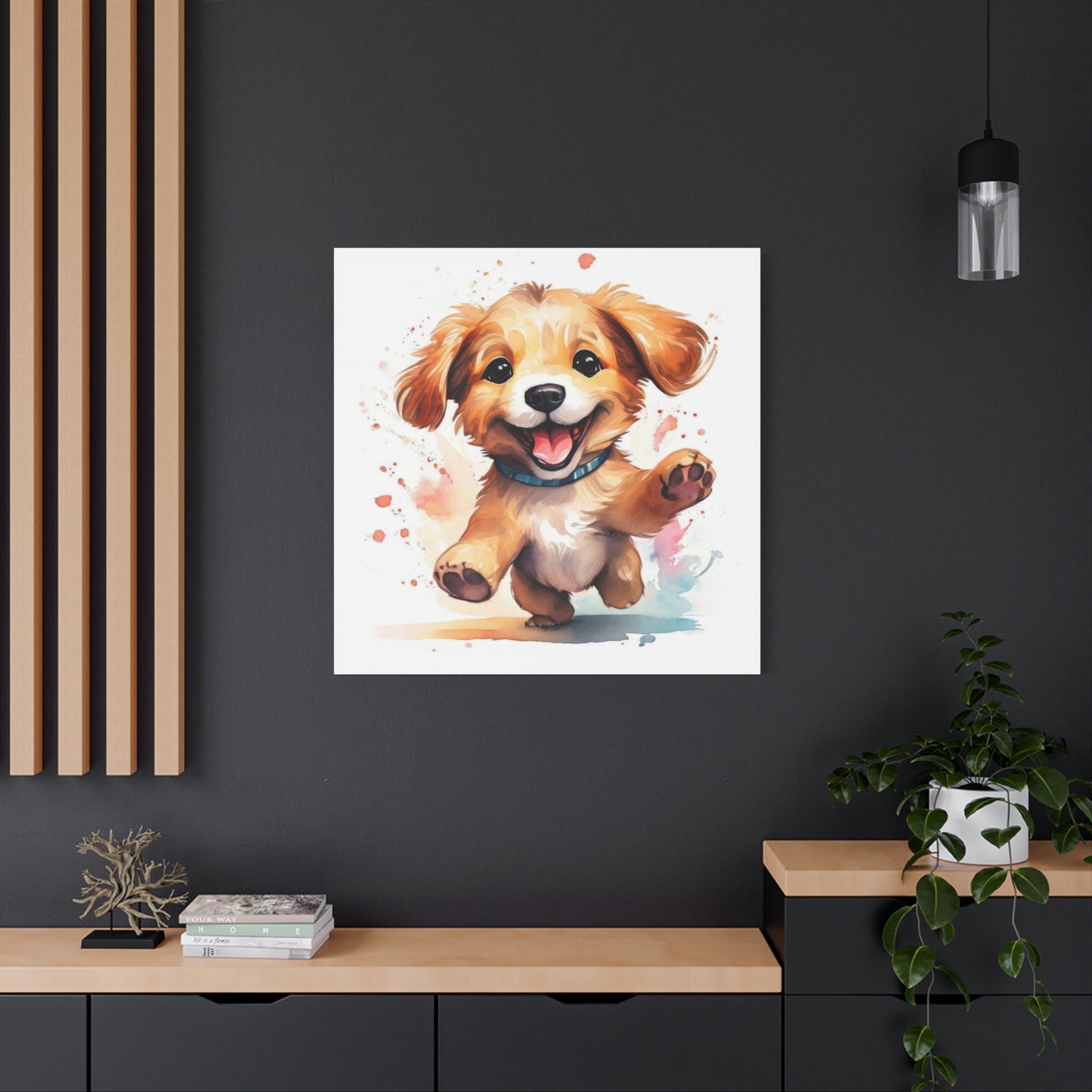Embodiment of Bliss: A Comprehensive Guide to Happy Dancing Dog Puppy Wall Art
In the vast and varied chronicle of human habitation, the quest to create a sanctuary of personal expression and comfort remains a constant endeavor. We paint walls, select furnishings, and arrange objects with a deep-seated desire to craft an environment that not only shelters us but also reflects the innermost facets of our being. Within this pursuit of a personalized haven, the adornment of our vertical spaces plays a pivotal role. Walls are not mere structural necessities; they are expansive canvases awaiting a narrative, blank slates yearning for a splash of emotion and personality. It is upon these surfaces that we hang mirrors to reflect light, shelves to hold our stories in the form of books and keepsakes, and, most importantly, compositions that speak directly to our souls. Among the infinite array of visual statements one can make, a uniquely cheerful and profoundly uplifting genre has emerged, capturing hearts with its unadulterated glee: happy dancing dog puppy wall art.
This is not merely about decoration. To categorize these vibrant, kinetic depictions as simple ornamentation would be to overlook their remarkable capacity to transform an atmosphere. A canvas featuring a puppy in a moment of pure, uninhibited dance is a vessel of joy, a conduit for an infectious positivity that can permeate a room and influence the disposition of its inhabitants. It is a celebration of life’s simplest, most potent pleasures, distilled into a single, captivating image. The appeal is universal, transcending cultural and demographic boundaries, for the sight of a jubilant young animal resonates with a primal part of our own longing for freedom and happiness. This comprehensive guide delves into the enchanting world of these delightful creations. We will journey through their intrinsic charm, explore their profound impact on our living spaces, and provide insights into selecting, placing, and cherishing these wonderful emblems of canine exuberance. Prepare to discover how a simple print of a pirouetting pup can do more than just fill a space on a wall; it can fill your home with a palpable sense of warmth, laughter, and perpetual, tail-wagging bliss.
Infusing Your Abode with Unfettered Whimsy through Dancing Puppy Compositions
In the lexicon of interior design, the term 'whimsy' signifies a departure from the predictable, an embrace of the playfully quaint and fanciful. It is the element that introduces a spark of the unexpected, transforming a meticulously designed room from a sterile showroom into a living, breathing space with a soul. Whimsy is the gentle rebellion against the rigidity of convention, a nod to the child-like wonder that resides within us all. There is, perhaps, no greater embodiment of this concept in home décor than the dancing puppy composition. These creations inherently break the mold of traditional wall adornments. They eschew the solemnity of classical landscapes, the abstract intellectualism of modernism, and the formal composure of portraiture. Instead, they offer a burst of pure, unadulterated fun. A single image of a puppy, mid-jig, with ears flopping and paws akimbo, tells an instantaneous story of carefree delight. It does not ask for deep interpretation; it commands a smile. This is its power and its purpose.
The narrative force of such a seemingly simple image is extraordinary. It captures a fleeting moment of unselfconscious joy, a concept that is both aspirational and deeply relatable. The implied motion within the static frame is a marvel of artistic interpretation. Artists employ a variety of methods to convey this sense of kinesis: the blur of a wagging tail, the dynamic posture of a pounce, the upward tilt of a snout in a moment of sheer exultation. This illusion of movement infuses the entire room with a subtle energy, preventing the space from feeling static or staid. The color palettes frequently utilized in these pieces are themselves a study in mood elevation. From brilliant, sun-drenched yellows and electrifying blues to soft, gentle pastels, the hues are chosen to amplify the cheerful subject matter. Even a monochromatic rendering, with a single, surprising pop of color on a collar or a toy, can create a sophisticated yet playful effect. By hanging a dancing puppy print, one is making a deliberate choice to inject a dose of lightheartedness and personality into their surroundings, effectively transforming a mere house into a home that doesn't take itself too seriously, a home that values and celebrates the beauty of a joyous moment.
Capturing the Spirit of Playfulness in Enduring Canvas Prints
In a world of fleeting trends and disposable goods, there is a deep and abiding appeal in objects that are designed to last, to become part of the enduring landscape of our lives. A canvas print that captures the spirit of playfulness is not just a decorative item; it is a potential heirloom, a memento that can carry emotional significance for years to come. The key to this longevity lies in the quality of its creation. A truly lasting piece is crafted from superior materials: archival-quality inks that resist fading over time, and a robust, tightly woven canvas stretched over a sturdy wooden frame. These elements ensure that the vibrancy of the colors and the clarity of the image remain intact, allowing the piece to continue radiating its cheerful energy for a generation or more. There is a palpable difference between a mass-produced, generic print and a thoughtfully selected, high-quality creation. The latter has a weight, a substance, and a visual depth that speaks of craftsmanship and care.
These enduring prints can serve a particularly poignant purpose as a memorial to a beloved pet that has crossed the rainbow bridge. While photographs capture a literal likeness, a dancing dog composition captures something more ethereal yet equally important: the animal's spirit. It chooses to commemorate not the absence or the sadness of loss, but the effervescent, playful soul that brought so much joy. In this context, the canvas becomes a beautiful tribute, a daily reminder of the happy times and the indelible mark the pet left on the hearts of its family. Furthermore, the theme of playfulness itself has a timeless and universal appeal. It is an emotion that knows no age. A dancing puppy can bring a smile to the face of a toddler, a teenager, a working adult, and a retiree with equal efficacy. It taps into a fundamental aspect of what it means to be alive and to find joy in movement and spontaneity. Choosing to hang such a piece is an investment in a durable, high-quality object that will perpetually serve as a beacon of lightheartedness and a testament to the enduring power of a playful spirit.
Weaving Jubilance into Your Living Space with Cheerful Puppy Wall Hangings
The discipline of interior design is, at its core, the artful manipulation of space to evoke a specific feeling or function. Within this practice, visual art serves as one of the most powerful tools for establishing a room's mood and focal point. A cheerful puppy wall hanging, with its inherent vibrancy and charm, can become the centerpiece around which a living space's entire personality is built. When used as a focal point, for example, above a sofa in the living room or on the main wall of an entryway, it immediately sets a welcoming and lighthearted tone for the entire home. It is an instant conversation starter, an unambiguous declaration of the home's cheerful disposition. The immediate impact on a visitor is one of warmth and accessibility; it signals that this is a space for comfort, relaxation, and happiness.
The principles of color theory are crucial when integrating such a piece into an existing décor scheme. The process can be approached in several ways. One might choose a print whose dominant colors match the existing palette of the room, creating a harmonious and cohesive look. Alternatively, one could select a canvas with a bold, contrasting color to act as a dramatic accent, injecting a burst of energy into a more neutral space. A room decorated in shades of grey and beige, for instance, could be instantly enlivened by a print featuring a puppy dancing against a brilliant turquoise or sunny orange background. The challenge and the delight lie in striking the perfect balance between sophistication and playfulness. A whimsical subject does not necessitate an immature design scheme. When a playful print is paired with elegant furnishings, high-quality textiles, and thoughtful lighting, the result is a space that feels both refined and joyfully alive. It is a testament to a design sensibility that values both aesthetic beauty and emotional resonance, proving that a truly sophisticated space is one that makes room for a smile.
Injecting Vivacious Energy into a Child's Sanctuary
The spaces we design for children are of paramount importance. A child's room is more than just a place for sleep; it is their first personal universe, a sanctuary for play, a classroom for the imagination, and a safe harbor for dreams. The visual elements within this sanctuary can have a profound impact on their development, mood, and creativity. It is in this context that happy dancing dog art finds one of its most perfect homes. The theme is an ideal match for nurseries, bedrooms, and playrooms, as it radiates a positive, vivacious energy that is both stimulating and comforting. For an infant in a nursery, the bright colors and friendly shapes can provide gentle visual stimulation. For a toddler, the image of a playful puppy can become a familiar, friendly presence, a character in their burgeoning world of make-believe.
These compositions are magnificent catalysts for the imagination. A single image of a dancing dog can become the starting point for countless bedtime stories and imaginative games. Questions like, "Why do you think the puppy is dancing?" or "What song is he listening to?" can open up avenues of creative thought and linguistic development. The overarching goal is to create an environment that feels happy, safe, and nurturing, and these canvases contribute directly to that aim. The sight of a perpetually cheerful, four-legged friend can be deeply comforting to a child, helping to ward off nighttime fears and foster a sense of security. The artistic styles can be chosen to match the child's age and the room's overall theme. Bright, bold, cartoon-style graphics are perfect for a vibrant playroom, while softer, watercolor-inspired prints can create a more serene and dreamy atmosphere in a nursery. Furthermore, from a practical standpoint, canvas prints are an excellent choice for a child's environment. They are typically lightweight, easy to hang, and lack the breakable glass of traditional framed pictures, making them a safer and more durable option for a space dedicated to the boisterous energy of childhood.
Curating a Haven of Bliss with Zestful Canine Compositions
The transformative power of joyful canine art need not be confined to a single room. For those who are truly captivated by its charm, it is possible to extend this theme throughout the home, curating a cohesive and uplifting atmosphere that flows from one space to the next. This is the concept of creating a "puppy haven," a home where every corner holds the potential for a smile. The key to achieving this without overwhelming the senses is to strive for thematic consistency rather than exact repetition. One might choose a series of prints by the same artist, which share a common style but depict different breeds or poses. Alternatively, one could select pieces from various creators that are united by a similar color palette or mood. This approach ensures a sense of continuity and intentionality, making the home feel like a thoughtfully curated gallery of happiness.
This "haven" concept can be adapted to specific zones within the home to enhance their function and feel. In a cozy reading nook, a small, charming print of a dancing beagle can add a touch of whimsy and companionship. In a home office, a space often associated with stress and concentration, a vibrant canvas of a leaping terrier can serve as a welcome mental break, a reminder to find moments of joy even during a busy workday. Even utilitarian spaces like kitchens and laundry rooms can be elevated by such an addition. A cheerful print next to the coffee maker can start the morning on a positive note, while a playful image in the laundry room can make mundane chores feel a little less tedious. The art is to integrate these pieces in a way that feels organic and tasteful. Pairing the canvases with other complementary décor elements is essential. A cushion on the sofa that picks up a minor color from the print, a rug with a subtle pattern that echoes the energy of the piece, or a vase of fresh flowers in a coordinating hue can all help to tie the room together, creating a polished and deeply personal environment that is, in every sense of the word, a true haven of bliss.
Innovative Design Concepts for Pet-Centric Wall Arrangements
Moving beyond the placement of a single, standalone piece, there are numerous innovative ways to incorporate pet-centric compositions into your home's design, particularly through the creation of dynamic wall arrangements. One of the most popular and expressive methods is the gallery wall. This involves grouping several pieces together to create a single, impactful visual statement. A pet-themed gallery wall can be incredibly personal and charming. One could create a collection centered exclusively on dancing puppy prints, showcasing a variety of breeds and artistic styles. A more eclectic approach might involve mixing these playful canvases with cherished family photographs of your own pets, elegant typographic prints featuring heartwarming quotes about dogs, and other complementary visual elements like small mirrors or textural hangings. This mix-and-match method allows you to tell a richer, more nuanced story on your wall.
The sizing and scaling of your chosen pieces are critical considerations. A single, oversized canvas of a dancing pup can serve as a dramatic, high-impact focal point in a large room with high ceilings. Conversely, a curated collection of smaller prints can create an intimate and detailed display, perfect for a smaller wall, a hallway, or the space above a console table. The choice of framing also dramatically affects the final presentation. A gallery wrap, where the canvas extends around the sides of the stretcher bars, offers a clean, modern look. A floating frame, which leaves a small gap between the canvas and the frame, adds a touch of sophistication and makes the composition appear to hover. Traditional frames can be chosen to match your existing furnishings, whether they are ornate and classic or simple and rustic. When planning your arrangement, especially for a gallery wall, it's wise to lay out the pieces on the floor first or to create paper templates to tape to the wall. This allows you to experiment with different layouts—symmetrical grids, organic clusters, or linear arrangements—before committing to nails and hooks. By thoughtfully considering these design concepts, you can elevate your pet-themed décor from a simple display to a sophisticated and deeply personal wall arrangement.
A Burst of Merriment for Contemporary Living Spaces
Contemporary interior design is often characterized by clean lines, neutral color palettes, uncluttered spaces, and a focus on form and material. While this minimalist aesthetic can be incredibly chic and calming, it sometimes runs the risk of feeling cold, impersonal, or sterile. This is where a carefully chosen piece of art can work wonders, and a composition featuring a joyful, dancing dog can be a surprisingly perfect antidote to excessive seriousness. The juxtaposition of a playful, whimsical piece of art against a backdrop of sleek, modern design creates a powerful and engaging visual tension. It introduces a "burst of merriment," an unexpected splash of fun that humanizes the space and reveals the personality of its inhabitants. This single element can prevent a minimalist room from feeling like a museum, transforming it into a welcoming and livable home.
In this context, the art becomes a true statement piece. In a room dominated by shades of white, black, and grey, a vibrant canvas with a pop of brilliant color can draw the eye and serve as the room's emotional heart. It demonstrates a confident design sense, one that understands that rules can be broken and that a touch of the unexpected is often the hallmark of a truly great interior. However, not all dancing dog prints will suit a contemporary aesthetic. The key is to select a style that complements the modern ethos. Abstract interpretations of the theme, where the form of the dog is suggested rather than rendered in detail, can work beautifully. Graphic, pop-art-inspired designs with their bold outlines and flat fields of color also harmonize well with modern furnishings. Even a monochromatic piece, perhaps in black and white or sepia tones, can add a touch of playful energy without disrupting a carefully controlled color scheme. By integrating such a piece, you are not diluting the modern design but rather enhancing it, proving that contemporary living spaces can be both sophisticated and full of soul.
Enlivening Empty Walls with Motion and Mirth
The problem of the "blank wall" is a common design dilemma. A large, empty expanse of wall can make a room feel unfinished, impersonal, and lacking in character. While there are many potential solutions—mirrors, shelving, textural treatments—art remains the most potent and expressive remedy. It is the quickest way to infuse a space with color, personality, and emotion. When the goal is to bring not just visual interest but also a sense of liveliness and energy, a composition depicting a dancing dog is an exceptionally effective choice. The secret lies in the power of implied motion. Unlike a static landscape, a serene still life, or a formal portrait, a print of a leaping, twirling puppy creates a dynamic feel that resonates throughout the room.
This illusion of kinesis encourages the viewer's eye to travel across the canvas, following the imagined arc of the puppy's jump or the swish of its tail. This visual journey introduces a subtle energy that prevents the room from feeling static. The composition is not just something to be looked at; it is something that is experienced. This inherent dynamism makes these pieces particularly useful in defining zones within an open-plan living area. For example, a lively print placed above a seating arrangement can help to visually anchor that area and designate it as a space for social interaction and relaxation, distinct from a nearby dining or kitchen area. Furthermore, the "mirth" aspect is just as important as the "motion." The cheerful subject matter ensures that the energy brought into the space is positive and uplifting. It solves the blank wall problem not just by filling the void, but by filling it with a palpable sense of joy and exuberance, fundamentally altering the room's atmosphere for the better.
Assembling Your Personal Exhibit with Charming Dancing Pups
Creating a gallery wall is akin to curating your own personal exhibit; it is a chance to be your own museum director, telling a story through a carefully selected collection of images. When the theme is charming dancing pups, the narrative is one of joy, playfulness, and affection. To assemble a truly compelling exhibit, it is helpful to first decide on the curatorial theme. Do you want to maintain a high degree of consistency, or embrace a more eclectic, bohemian vibe? For a consistent look, you could choose prints that all share a similar artistic style, such as a collection of watercolor renderings, or a series of graphic-style illustrations. You could also unify the collection through a shared color palette, selecting pieces that all feature shades of blue, for example, to complement your room's décor. The choice of frames can also serve as a unifying element; using identical frames for all the pieces will create a very orderly and polished look.
Conversely, an eclectic approach can be equally stunning and often more personal. This involves mixing and matching different styles, sizes, and even frame types. A modern, minimalist print of a dancing dog could be hung next to a vintage-style piece, which could be placed beside a personal photograph. The frames could be a mix of black, white, wood, and metallic finishes. The key to making this style work is to find a common thread, however subtle. This might be the shared subject matter of dogs, or a single color that appears in each piece, tying the disparate elements together. Before you begin hammering, the planning stage is paramount. Arrange all your chosen pieces on a large patch of floor. Move them around, experiment with spacing, and live with the layout for a day or two. Once you are satisfied, create paper cutouts of each frame and tape them to the wall. This allows you to visualize the final arrangement perfectly and make any necessary adjustments without creating unnecessary holes. This thoughtful process will transform a simple collection of pictures into a cohesive, personal, and utterly charming exhibit that brings a smile to your face every time you pass by.
Harnessing Positive Energy: Concepts for Canine-Themed Decorations
The environment in which we live has a subtle but undeniable influence on our emotional and mental state. The colors, objects, and images we surround ourselves with can contribute to feelings of calm, anxiety, creativity, or joy. The conscious decision to incorporate canine-themed decorations, particularly those depicting happy, dancing animals, is an active step towards harnessing positive energy and cultivating a home environment that supports well-being. This concept is about more than just aesthetics; it is about creating a space that functions as a sanctuary, a place of emotional replenishment. A piece of art showing a gleeful puppy is a powerful visual cue. It serves as a constant, gentle reminder to seek out and appreciate the joyful moments in our own lives, however small they may be.
This imagery can act as an anchor to positive emotions. In moments of stress or sadness, the glance towards a picture of pure, uninhibited delight can provide a momentary but meaningful mental shift. It can break a cycle of negative thought and introduce a glimmer of lightheartedness. This is not to suggest that a piece of art is a cure-all, but rather that it is a valuable tool in the practice of creating a supportive and uplifting personal space. These decorations embody a "paws-itive" philosophy. They celebrate the simple, profound happiness that comes from living in the moment, a skill that dogs possess in abundance and that humans often strive to emulate. By choosing to fill our walls with such imagery, we are making a statement about the values we wish to cultivate in our lives and in our homes: values of joy, playfulness, optimism, and an appreciation for the loving companionship of our animal friends. It is an intentional act of curating not just a beautiful space, but a happy one.
Vivid Portrayals of Canine Euphoria
Color is the language of emotion in the visual world, and in the genre of dancing dog art, it is used with magnificent fluency to portray a state of pure canine euphoria. The artists who create these pieces are masters of chromatic storytelling, selecting hues that amplify the joyful energy of their subjects. A detailed exploration of their color choices reveals a deliberate and impactful strategy. Bright, saturated colors are often employed to convey high energy and unadulterated glee. A splash of canary yellow, the color of sunshine and optimism, can dominate a background or highlight a playful accessory. A vibrant turquoise or cerulean blue can evoke a sense of boundless, clear-skied freedom. A fiery red or a zesty orange can communicate passion, excitement, and boundless vitality. These vivid palettes make the compositions leap off the wall, infusing the entire room with their infectious ebullience.
Conversely, a softer, pastel palette can be used to depict a more gentle and dreamy form of happiness. Lavender, mint green, powder blue, and soft pink can create a sense of whimsical serenity, a quiet and contented joy. This approach is often seen in pieces intended for nurseries or tranquil spaces like bedrooms. The artists also masterfully use color to direct the viewer's focus. A neutral, muted background can make a brightly colored puppy the undeniable star of the show. Sometimes, the color choices are fantastical and imaginative rather than realistic. A purple poodle dancing on a green cloud, for example, immediately transports the viewer to a world of make-believe and pure fun, untethered from the constraints of reality. The color scheme of the chosen art piece can have a profound effect on the mood of the room it inhabits. A predominantly blue canvas can lend a calming yet cheerful air, while a piece rich in yellows and oranges will create a more energizing and sociable atmosphere. Understanding this powerful interplay between color and emotion is key to selecting a piece that will perfectly harmonize with and enhance your living space.
The Phenomenon of Implied Kinesis in Canine-Themed Canvases
One of the most captivating aspects of dancing dog compositions is their ability to convey a powerful sense of movement—or kinesis—within the confines of a static, two-dimensional medium. This "magic of motion" is not magic at all, but a collection of sophisticated artistic methods designed to trick the eye and stimulate the brain into perceiving action. A closer, more analytical look at these canvases reveals the cleverness behind the illusion. Artists often employ blurred lines or softened edges, particularly around the paws or the tip of the tail, to simulate the effect of rapid movement, similar to what a camera captures with a slightly slow shutter speed. The dynamic pose of the dog is the most crucial element. Instead of a formal, seated or standing position, the dogs are captured mid-leap, mid-twirl, or in a deep play-bow, their bodies contorted in ways that suggest momentum and energy.
The details of the dog's anatomy are exaggerated to enhance this effect. Ears are often depicted flying back, jowls flapping, and fur appearing windswept, all of which contribute to the narrative of vigorous motion. Compositional devices also play a vital role. The use of strong diagonal lines, whether in the posture of the dog or in the background elements, inherently creates more visual energy than stable horizontal or vertical lines. Leading lines can guide the viewer's eye along the path of the dog's imagined movement, further reinforcing the sense of action. The principles of composition, such as placing the subject slightly off-center according to the rule of thirds, can also make a scene feel more dynamic and less static. Comparing different artistic styles reveals various approaches to this challenge. An impressionistic painting might use loose, energetic brushstrokes to create a shimmering sense of movement, while a graphic illustration might use "whoosh" lines or starbursts, borrowing from the language of comics to signify action. It is this masterful creation of implied kinesis that makes these pieces so lively and engaging, allowing them to fill a room with an energy that a more placid subject simply cannot match.
A Fusion of Humor and Affection in Dancing Dog Compositions
Dancing dog compositions occupy a unique and endearing niche in the world of visual art, largely due to their masterful fusion of two powerful emotions: humor and heart. The comedic element is immediately apparent. There is an inherent, delightful absurdity in the image of a dog, an animal not known for its bipedal grace, engaging in a recognizably human activity like dancing. This anthropomorphism—attributing human characteristics to an animal—is a classic source of humor. We see a clumsy bulldog attempting a balletic leap or a lanky greyhound in a disco pose, and we cannot help but chuckle. The humor is gentle, warm, and born of affection, tapping into the goofy and often undignified antics we witness in our own pets. This lightheartedness makes the art accessible and universally appealing, requiring no deep intellectual analysis to be enjoyed.
Beneath this layer of humor, however, lies a profound current of affection and heart. These pieces are not mocking the animals; they are celebrating them. The dance is a metaphor for the boundless joy and love that dogs bring into our lives. It captures the essence of the deep emotional bond we share with our canine companions. We look at the image and see not just a funny animal, but a reflection of the happiness our own pets exude, the pure, uncomplicated glee they show when we return home or pick up a favorite toy. The artist's ability to balance these two elements is the key to the composition's success. A piece that is purely comical might feel shallow, while one that is overly sentimental could feel saccharine. The most effective dancing dog canvases find the perfect equilibrium. They make us laugh at the silly pose while simultaneously warming our hearts with the palpable sense of joy. They tap into our tendency to see our pets as furry, four-legged members of our family, with their own unique personalities and comical quirks. It is this skillful blend of humor and heartfelt affection that gives these creations their enduring emotional resonance.
The Quintessence of Happiness: Dancing Canine Editions
In a world saturated with complex and often challenging visual media, there is a refreshing purity to art that dedicates itself to the celebration of a single, positive emotion. The curated series and special editions of dancing canine canvases represent just that: they are an exploration of the quintessence of happiness. These collections are not merely about depicting dogs; they are about capturing the very essence of joy in its most uninhibited form. Artists who specialize in this theme often create cohesive series, or "editions," that explore different facets of this emotion. One edition might focus on the explosive energy of large breeds, while another might capture the delicate, bouncy glee of smaller ones. Some series might explore happiness through a specific color lens, creating a suite of images in varying shades of blue to represent tranquil joy, or in a spectrum of reds to signify passionate exuberance.
The concept of an "edition" also implies a level of collectibility and artistic intent. These are not random images but thoughtfully composed variations on a central theme. For an art lover or a dog enthusiast, collecting pieces from a particular series can be a deeply satisfying pursuit, allowing them to build a personal gallery dedicated to this uplifting subject. What elevates a piece to a true "edition of happiness" is this convergence of the artist's focused intention and the viewer's emotional reception. The artist sets out with the explicit goal of bottling joy onto a canvas, using their skills in composition, color, and form to achieve this. The viewer, in turn, responds to this intention, feeling the intended emotion and allowing it to resonate within their own experience. These editions serve as powerful reminders of life's simple pleasures. They champion the idea that happiness doesn't have to be grand or complicated; it can be found in a moment of spontaneous movement, a burst of carefree energy, a simple, joyful dance.
A Homage to Canine Bliss Through Rhythmic Puppy Prints
Rhythmic puppy prints depicting the act of dancing are, in their most profound sense, a homage to the unique and beautiful nature of canine bliss. They are a tribute to the remarkable capacity of dogs to experience and express pure, unadulterated joy. This is a quality that we, as humans, often admire and even envy. Dogs do not dance with self-consciousness or with any ulterior motive; they move with a spontaneous exuberance that comes directly from a place of contentment and excitement. These artistic compositions capture that pure expression and elevate it, holding it up as something to be celebrated and cherished. In doing so, they also honor the special relationship between humans and their canine companions.
The joy depicted in these prints is often a direct result of the love and care provided by their human families. A well-cared-for, happy dog is one that feels safe and loved enough to express itself with such carefree abandon. Therefore, the image of a dancing dog is also a subtle reflection of the rewards of responsible pet ownership. It symbolizes the beautiful, symbiotic relationship where our care and affection are returned to us in the form of boundless love and infectious happiness. Hanging such a piece on the wall serves as a daily acknowledgment of this bond. It is a visual celebration of the laughter, comfort, and companionship that dogs bring into our homes. These prints are not just about cute animals; they are about a specific, precious emotion—canine bliss—and they encourage a more positive and appreciative view of the animals with whom we share our lives, reminding us of the simple, profound lessons they teach us about living in the moment and finding joy in the everyday.
Choosing the Perfect Dancing Puppy Canvas for Your Space
Selecting the ideal piece of wall art is a delightful process that involves both practical considerations and personal taste. When it comes to choosing the perfect dancing puppy canvas, a systematic approach can help ensure you find a piece that you will treasure for years to come. The first step is to carefully assess your space. Consider the wall where you intend to hang the canvas. Measure its dimensions to determine the optimal size for the art. A small print can get lost on a large wall, while an oversized piece can overwhelm a small room. Think about the room's function; a high-energy, vibrant piece might be perfect for a living room or playroom, while a more serene, softly colored canvas might be better suited for a bedroom. Take note of the existing colors in the room, including the walls, furniture, and textiles, as this will guide your color palette choices.
Next, define your personal style. Are you drawn to modern, minimalist aesthetics, or do you prefer a more rustic, bohemian, or traditional feel? Look for artistic renderings that align with your taste. A graphic, pop-art style will suit a modern interior, whereas a soft, impressionistic piece might feel more at home in a cottage-style setting. Thirdly, consider the medium itself. While this guide focuses on canvas prints, which offer a textured, painterly feel, you might also consider giclée prints on fine art paper, which can be matted and framed for a more traditional look.
The quality of the creation is paramount. Look for details about the materials used. High-quality prints utilize archival inks that are resistant to fading, and are printed on thick, durable canvas. If it is a stretched canvas, check that the wooden frame (stretcher bars) is solid and warp-resistant. Finally, establish a budget. Wall art is available at a vast range of price points, so having a clear idea of what you are comfortable spending will help narrow down your options. By following these steps, you can move beyond simply liking an image and make a thoughtful, informed decision, selecting a dancing puppy canvas that is the perfect fit for your space, your style, and your soul.
Maintaining the Vibrancy of Your Canine Canvases
Once you have selected and installed your perfect piece of happy dancing dog art, a little care and maintenance will ensure it continues to bring joy and vibrancy to your space for many years. The longevity of a canvas print is largely dependent on its environment and how it is handled. The most common adversary of any art piece is dust. Regular, gentle dusting is the most important maintenance task. Use a soft, dry, clean cloth or a feather duster. Avoid using water or any chemical cleaning solutions, as these can damage the ink and the canvas material, causing streaking or fading. For any stubborn spots, a slightly damp cloth can be used with extreme care, but it should be tested on a small, inconspicuous corner first.
The placement of your canvas is crucial to its preservation. Direct sunlight is the enemy of color vibrancy. The ultraviolet (UV) radiation in sunlight can cause the inks to fade and the canvas to become brittle over time. To protect your investment, hang your canvas on a wall that does not receive prolonged, direct exposure to the sun. If this is unavoidable, consider investing in UV-protective window films or blinds. Humidity is another factor to consider. Excessively humid environments, such as a poorly ventilated bathroom, can promote the growth of mildew and cause the wooden stretcher frame to warp. Similarly, excessively dry environments, like directly over a heating vent, can cause the canvas to become brittle. A stable, temperate environment is ideal. If you plan to rotate your art and need to store a canvas, wrap it carefully in a clean, breathable fabric like a cotton sheet, and store it upright in a cool, dark, and dry place. By following these simple care instructions, you can ensure that the cheerful spirit of your dancing puppy canvas remains as bright and captivating as the day you first hung it.
The Diverse World of Dancing Dog Imagery
While the theme of "dancing dogs" is specific, the artistic interpretations within it are incredibly diverse, reflecting the vast and varied world of canines themselves. One of the most delightful aspects of this genre is the exploration of different breeds and how their unique physical characteristics and temperaments influence the depiction of their dance. You might find a canvas featuring a stocky, muscular bulldog in a surprisingly delicate and comical ballet pose, its charming clumsiness adding to the humor. Another piece might showcase the sleek, aerodynamic form of a greyhound in a graceful, sweeping leap, emphasizing its natural elegance and speed even in a moment of play. The joyful, boundless energy of a Golden Retriever might be captured in an explosive, star-shaped jump, while the quirky head-tilt of a French Bulldog could be the centerpiece of its unique shuffle.
This celebration of breed diversity allows collectors and dog lovers to find pieces that resonate with their personal favorites or even resemble their own pets. However, many artists also create abstract or non-breed-specific representations. These pieces focus more on the universal form and spirit of a dog, using suggestive lines and shapes to convey the idea of a canine in motion. This can be appealing for those who want to celebrate the concept of "dogness" in general, rather than a particular breed. The popularity of certain breeds often ebbs and flows with cultural trends, but classic favorites like Labradors, Poodles, and various terriers are perennial stars in this artistic niche. Whether you are drawn to the goofy antics of a Corgi or the elegant twirl of a Saluki, the diverse world of dancing dog imagery offers a rich and varied tapestry of choices, ensuring that there is a perfect, pirouetting pup for every preference.
Harmonizing Your Art with Different Interior Motifs
A piece of dancing dog art, with its inherent charm and playfulness, can be successfully integrated into virtually any interior design motif, provided the style of the art is chosen thoughtfully to complement the surrounding décor. The key is to create a harmonious dialogue between the canvas and the room. For a home with a Scandinavian design, known for its minimalism, functionality, and light color palette, the ideal choice would be a print with clean lines and a simple composition. A piece featuring a graphic outline of a dog on a white or soft pastel background, housed in a light wood or simple white frame, would fit seamlessly into the calm and uncluttered Scandi aesthetic.
In a Bohemian-themed space, which celebrates eclecticism, vibrant colors, and rich textures, you can be much bolder. A canvas bursting with a riot of color, perhaps featuring a dog dancing amidst a field of fantastical flowers or against a backdrop of intricate patterns, would feel right at home. This style encourages mixing and matching, so a richly detailed, free-spirited piece would enhance the creative and unconventional vibe. For an Industrial interior, characterized by raw materials like exposed brick, metal, and concrete, a high-contrast piece works best. A black and white graphic print with a bold, almost stencil-like quality, or a piece with a gritty, urban feel, perhaps housed in a simple black metal frame, would provide a perfect counterpoint to the raw textures of the space.
A rustic Farmhouse motif, with its emphasis on comfort, natural materials, and vintage charm, calls for a piece with a warm and gentle feel. A print that looks like a soft watercolor or a colored pencil sketch, featuring earthy tones and a charmingly simple depiction of a puppy, would complement the cozy and welcoming atmosphere. For a Coastal or beach-house style, which favors light, airy colors and natural light, a canvas with a palette of blues, whites, and sandy beiges would be ideal. An image of a dog joyfully leaping on a beach or against a simple sky-blue background would perfectly capture the carefree and relaxed spirit of coastal living. By carefully considering the dominant characteristics of your home's interior motif, you can select a dancing dog canvas that not only adds a touch of joy but also enhances the overall design cohesion of your space.
Conclusion
In the grand tapestry of home design, each thread we choose contributes to the overall story of our lives. The colors on our walls, the textures of our furnishings, and the images we choose to display are all chapters in this personal narrative. As we have explored throughout this extensive journey, the inclusion of happy dancing dog puppy wall art is a particularly eloquent and joyful statement. It is far more than a fleeting trend or a simple decorative flourish; it is a conscious and deliberate investment in the emotional climate of our personal sanctuary. It is an affirmation of the values of optimism, lightheartedness, and the profound, uncomplicated happiness that our canine companions so effortlessly embody.
We have seen how these whimsical compositions can infuse a space with an energy and personality that few other design elements can replicate. They serve as focal points that command smiles, as conversation starters that break the ice, and as daily, gentle reminders to find the joy in the present moment. From the nursery where they nurture a child's imagination to the contemporary living room where they inject a dose of soulful merriment, their versatility is matched only by their charm. We have delved into the artistic methods that create the magical illusion of motion and the careful balance of humor and heart that gives these pieces their deep emotional resonance.
Ultimately, the power of a dancing puppy canvas lies in its ability to connect with a fundamental human desire for happiness and connection. It captures a universal language of glee—a language spoken in wagging tails, floppy ears, and paws that move to an unheard, joyous rhythm. In choosing such a piece for your home, you are doing more than just filling a blank space on a wall. You are hanging a window into a world of pure positivity. You are curating an environment that not only pleases the eye but also nurtures the soul. So, as you continue to craft the story of your home, consider making room for this unique form of bliss. Seek out the canvas that speaks to you, the one that captures the spirit of a dance you wish to join, and let the pure, uninhibited glee of a happy puppy become a permanent and cherished part of your everyday life.

















